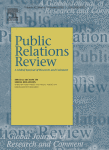Current Research Projects:
1) RANGE (NSF Growing Convergence Research)
2) Green Growth and Sámi Stakeholders
(Research Council of Norway)
3) Award-winning Research Group OU CHEPS
Latest Book
This book serves as a reader exploring the scholarly inquiry, professional education, and practice of Russian public relations and advertising in multiple contexts. It examines significant parts of what can be encompassed under the umbrella of strategic communications, including public relations and advertising, rather than investigating all areas of communication in Russia.
Praise for "Strategic Communications in Russia"
"The editors... created a unique and indispensable English language resource for a wide array of readers with an academic and/or applied interest in strategic communication(s) in Russia." JMCQ
Tsetsura and Kruckeberg "have assembled a sweeping analysis" of strategic communications in Russia... and "have made a significant contribution to our understanding of the importance of Russian strategic communications, as an area of scholarly inquiry, professional education, and practice, in contributing to the persuasive arts utilised by all role players in business, society, and global politics arenas."
Journal of International Communication
Media Transparency Publications

Transparency, Public Relations and the Mass Media
Combating the Hidden Influences in News Coverage Worldwide
By Katerina Tsetsura, Dean Kruckeberg
© 2017 – Routledge
"As a former journalist who moved into communications-related research, I found this an engaging and honest book that makes an impression, correctly identifying the multiple shades of black and white that can exist, without aggressively taking one side and hectoring adherence to a desired cause." JMCQ review
About the book: This book is about media transparency and good-faith attempts of honesty by both the sources and the gate-keepers of news and other information that the mass media present as being unbiased. Specifically, this book provides a theoretical framework for understanding media transparency and its antithesis--media opacity--by analyzing extensive empirical data that the authors have collected from more than 60 countries throughout the world. The practice of purposeful media opacity, which exists to greater or lesser extents worldwide, is a powerful hidden influencer of the ostensibly impartial media gate-keepers whose publicly perceived role is to present news and other information based on these gate-keepers’ perception of this information’s truthfulness. Empirical data that the authors have collected globally illustrate the extent of media opacity practices worldwide and note its pervasiveness in specific regions and countries. The authors examine, from multiple perspectives, the complex question of whether media opacity should be categorically condemned as being universally inappropriate and unethical or whether it should be accepted—or at least tolerated—in some situations and environments.
Klyueva, A., & Tsetsura, K. (2015). Economic foundations of morality: Questions of transparency and ethics in Russian journalism.
This study examines the questions of ethics and transparency in Russian journalism. The paper explains instances of non-transparent behavior among Russian journalists in light of economic...
Tsetsura, K. Media Non-transparency: How it affects your story
The handout was prepared by Dr. Tsetsura and her colleagues for a presentation at the PRSA 2011 International Conference Workshop. They “used the activity on the second page to generate discussion about the importance of media transparency.”
Klyueva, A., & Tsetsura, K. (2011). News from the Urals with love and payment: The first look at non-transparent media practices in the Urals Federal District of Russia.
We live in the world where ‘info-enthusiasm rules the day’, as Isaac Catt so aptly puts it in his The signifying world between ineffability and intelligibility: Body as sign in communicology (2011, p. 123).

Tsetsura, K., & Luoma-aho, V. (2010). Innovative thinking or distortion of journalistic values? How the lack of trust creates non-transparency in the Russian media. .
Tsetsura, K., & Luoma-aho, V. (2010). Innovative thinking or distortion of journalistic values? How the lack of trust creates non-transparency in the Russian media. Ethical Space: The International Journal of Communication Ethics, 7(4), 30-38.

Tsetsura, K., & Kruckeberg, D. (2004). Contemporary Russian journalism’s problems and opportunities.
(pp. 242-256), a part of the chapter “Eastern Europe, the newly independent states of Eurasia, and Russia.” In A. S. de Beer and J. C. Merrill (Eds.), Global journalism, 4th ed. (pp. 212-256). Boston: Pearson Allyn & Bacon.

Kruckeberg, D., & Tsetsura, K. (2004). International journalism ethics. In A. S. de Beer and J. C. Merrill (Eds.).
What's this item about? What makes it interesting? Write a catchy description to grab your audience's attention...
Kruckeberg, D., & Tsetsura, K. (2003). International index of bribery for news coverage: A composite index by country of variables related to the likelihood of the existence of “cash for news coverage.”
Bribery of the news media in too many countries robs citizens of credible information they need to make personal and collective decisions.















